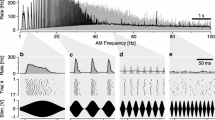Summary
Physiological recordings were obtained from identified receptors in the tympanal organ ofGryllus bimaculatus. By immersing the prothoracic leg in Ringer solution and removing the anterior tympanic membrane the auditory receptors were exposed without significantly altering the frequency response of the auditory organ (Fig. 1). Each receptor was tuned to a specific sound frequency. For sound frequencies below this characteristic frequency the roll-off in sensitivity decreased from 20–30 dB/octave to 10–15 dB/octave as the characteristic frequency of receptors increased from 3–11 kHz (Fig. 4A). For each individual receptor the slope, dynamic range and maximum spike response were similar for different sound frequencies (Fig. 9A). The receptors were tonotopically organized with the characteristic frequency of the receptors increasing from the proximal to the distal end of the array (Figs. 5, 6). Several receptors had characteristic frequencies of 5 kHz. These receptors were divided into two groups on the basis of their maximum spike response produced in response to pure tones of increasing intensity (Fig. 7). Independent of the tuning of the receptor no two-tone inhibition was observed in the periphery, thus confirming that such interactions are a property of central integration.
Similar content being viewed by others
References
Alexander RD (1961) Aggressiveness, territoriality, and sexual behavior in field crickets (Orthoptera: Gryllidae). Behaviour 17:130–223
Boyd P, Lewis B (1983) Peripheral auditory directionality in the cricket (Gryllus campestris L.,Teleogryllus oceanicus Le Guillou). J Comp Physiol 153:523–532
Chukanov VS, Korsunovskaja OS, Zhantiev RD (1982) Frequency characteristics of the auditory receptors inGryllus bimaculatus DeGeer (Orthoptera, Gryllidae). Rev Entomol URSS 61:3–7
Eibl E (1978) Morphology of the sense organs in the proximal parts of the tibiae ofGryllus campestris L. andGryllus bimaculatus DeGeer (Insecta, Ensifera). Zoomorphologie 89:185–205
Esch H, Huber F, Wohlers DW (1980) Primary auditory neurons in crickets: physiology and central projections. J Comp Physiol 137:27–38
Hill KG, Boyan GS (1976) Directional hearing in crickets. Nature 262:390–391
Hill KG, Boyan GS (1977) Sensitivity to frequency and direction of sound in the auditory system of crickets (Gryllidae). J Comp Physiol 121:79–97
Huber F, Kleindienst H-U, Weber T, Thorson J (1984) Auditory behavior of the cricket. III. Tracking of male calling song by surgically and developmentally one-eared females, and the curious role of the anterior tympanum. J Comp Physiol A 155:725–738
Hutchings M, Lewis B (1981) Response properties of primary auditory fibers in the cricketTeleogryllus oceanicus. J Comp Physiol 143:129–134
Kleindienst H-U, Wohlers DW, Larsen ON (1983) Tympanal membrane motion is necessary for hearing in crickets. J Comp Physiol 151:397–400
Larsen ON, Michelsen A (1978) Biophysics of the ensiferan ear. III. The cricket ear as a four-input system. J Comp Physiol 123:217–227
Larsen ON, Surlykke A, Michelsen A (1984) Directionality of the cricket ear: a property of the tympanal membrane. Naturwissenschaften 71:538
Michel K (1974) Das Tympanalorgan vonGryllus bimaculatus DeGeer (Saltatoria, Gryllidae). Z Morphol Tiere 77:285–315
Nocke H (1972) Physiological aspects of sound communication in crickets (Gryllus campestris L). J Comp Physiol 80:141–162
Oldfield BP (1982) Tonotopic organisation of auditory receptors in Tettigoniidae (Orthoptera: Ensifera). J Comp Physiol 147:461–469
Oldfield BP (1983) Central projections of primary auditory fibers in Tettigoniidae (Orthoptra: Ensifera). J Comp Physiol 151:389–395
Oldfield BP (1984) Physiology of auditory receptors in two species of Tettigoniidae (Orthopteera: Ensifera): Alternative tonotopic organisations of the auditory organ. J Comp Physiol A 155:689–696
Oldfield BP (1985) The tuning of auditory receptors in bushcrickets. Hearing Res 17:27–35
Otte D, Alexander RD (1983) The australien crickets (Orthoptera: Gryllidae). Academy of Natural Sciences of Philadelphia (Monograph 22)
Popov AV, Shuvalov VF, Svetlogorskaya ID, Markovich AM (1974) Acoustic behaviour and auditory system in insects. In: Schwartzkopff J (ed) Mechanoreception. Abh RheinWestf Akad Wiss 53:281–306
Rheinlaender J (1975) Transmission of acoustic information at three neuronal levels in the auditory system ofDecticus verrucivorus (Tettigoniidae, Orthoptera). J Comp Physiol 97:1–53
Stewart WW (1978) Functional connections between cells as revealed by dye coupling with a highly fluorescent naphthalimide tracer. Cell 14:741–759
Wohlers DW, Huber F (1982) Processing of sound signals by six types of neurons in the prothoracic ganglion of the cricket,Gryllus campestris L. J Comp Physiol 146:161–173
Young D, Ball E (1974) Structure and development of the auditory system in the prothoracic leg of the cricketTeleogryllus commodus (Walker). I. Adult structure. Z Zellforsch 147:293–312
Zhantiev RD, Chukanov VS (1972) Frequency characteristics of tympanal organs of the cricketGryllus bimaculatus deGeer (Orthoptera: Gryllidae). Vestn MGU, Ser VI 2:3–8
Author information
Authors and Affiliations
Rights and permissions
About this article
Cite this article
Oldfield, B.P., Kleindienst, H.U. & Huber, F. Physiology and tonotopic organization of auditory receptors in the cricketGryllus bimaculatus DeGeer. J. Comp. Physiol. 159, 457–464 (1986). https://doi.org/10.1007/BF00604165
Accepted:
Issue Date:
DOI: https://doi.org/10.1007/BF00604165




